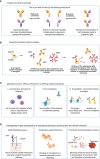IgG4 Autoantibodies in Organ-Specific Autoimmunopathies: Reviewing Class Switching, Antibody-Producing Cells, and Specific Immunotherapies
- PMID: 35401530
- PMCID: PMC8986991
- DOI: 10.3389/fimmu.2022.834342
IgG4 Autoantibodies in Organ-Specific Autoimmunopathies: Reviewing Class Switching, Antibody-Producing Cells, and Specific Immunotherapies
Abstract
Organ-specific autoimmunity is often characterized by autoantibodies targeting proteins expressed in the affected tissue. A subgroup of autoimmunopathies has recently emerged that is characterized by predominant autoantibodies of the IgG4 subclass (IgG4-autoimmune diseases; IgG4-AID). This group includes pemphigus vulgaris, thrombotic thrombocytopenic purpura, subtypes of autoimmune encephalitis, inflammatory neuropathies, myasthenia gravis and membranous nephropathy. Although the associated autoantibodies target specific antigens in different organs and thus cause diverse syndromes and diseases, they share surprising similarities in genetic predisposition, disease mechanisms, clinical course and response to therapies. IgG4-AID appear to be distinct from another group of rare immune diseases associated with IgG4, which are the IgG4-related diseases (IgG4-RLD), such as IgG4-related which have distinct clinical and serological properties and are not characterized by antigen-specific IgG4. Importantly, IgG4-AID differ significantly from diseases associated with IgG1 autoantibodies targeting the same organ. This may be due to the unique functional characteristics of IgG4 autoantibodies (e.g. anti-inflammatory and functionally monovalent) that affect how the antibodies cause disease, and the differential response to immunotherapies of the IgG4 producing B cells/plasmablasts. These clinical and pathophysiological clues give important insight in the immunopathogenesis of IgG4-AID. Understanding IgG4 immunobiology is a key step towards the development of novel, IgG4 specific treatments. In this review we therefore summarize current knowledge on IgG4 regulation, the relevance of class switching in the context of health and disease, describe the cellular mechanisms involved in IgG4 production and provide an overview of treatment responses in IgG4-AID.
Keywords: Fab-arm exchange; IL-10; IL-4; IgG4 autoimmune disease; MHC; autoimmunity; memory B cells.
Copyright © 2022 Koneczny, Tzartos, Mané-Damas, Yilmaz, Huijbers, Lazaridis, Höftberger, Tüzün, Martinez-Martinez, Tzartos and Leypoldt.
Conflict of interest statement
JT and ST have shares in the research and diagnostic laboratory Tzartos NeuroDiagnostics, Athens. FL discloses having received speaker honoraria from Grifols, Teva, Biogen, Bayer, Roche, Novartis, Fresenius, travel funding from Merck, Grifols and Bayer and serving on advisory boards for Roche, Biogen and Alexion. MH Is a member of the European Reference Network for Rare Neuromuscular Diseases and The Netherlands Neuromuscular Center. MH is a co-inventor on two patent applications on MuSK-related research. LUMC and MH receive license income from these patents. LUMC receives royalties on a MuSK ELISA. The remaining authors declare that the research was conducted in the absence of any commercial or financial relationships that could be construed as a potential conflict of interest.
Figures


References
Publication types
MeSH terms
Substances
Grants and funding
LinkOut - more resources
Full Text Sources
Medical
Research Materials

